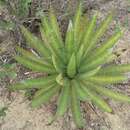fr
noms dans le fil d’Ariane


Agave univittata, the thorn-crested century plant or thorn-crested agave,[3] is a plant species native to coastal areas of southern Texas and northeastern Mexico, at elevations less than 100 m (300 feet). It has been widely named Agave lophantha[3] by botanists including Howard Scott Gentry,[4] but the name A. univittata is older and therefore more in accord with nomenclatural rules of botany.[5]
Agave univittata has thick, fleshy leaves that are stiff and undulate (wavy) along the margins. It has sharp and prominent spines on the edges and tips of the leaves. Flowering stalk is up to 5 m (16 feet) tall, bearing greenish-white to yellow-ish green flowers.[3][4]
It is cultivated as an ornamental plant, and in the UK the cultivar 'Quadricolor' has won the Royal Horticultural Society's Award of Garden Merit.[6][7]
Because the species is widespread and the overall population is stable, it is not considered by the IUCN to be threatened.[1]
Agave univittata, the thorn-crested century plant or thorn-crested agave, is a plant species native to coastal areas of southern Texas and northeastern Mexico, at elevations less than 100 m (300 feet). It has been widely named Agave lophantha by botanists including Howard Scott Gentry, but the name A. univittata is older and therefore more in accord with nomenclatural rules of botany.
Agave univittata has thick, fleshy leaves that are stiff and undulate (wavy) along the margins. It has sharp and prominent spines on the edges and tips of the leaves. Flowering stalk is up to 5 m (16 feet) tall, bearing greenish-white to yellow-ish green flowers.
It is cultivated as an ornamental plant, and in the UK the cultivar 'Quadricolor' has won the Royal Horticultural Society's Award of Garden Merit.
Because the species is widespread and the overall population is stable, it is not considered by the IUCN to be threatened.
Agave univittata là một loài thực vật có hoa trong họ Măng tây. Loài này được Haw. mô tả khoa học đầu tiên năm 1831.[2]
Agave univittata là một loài thực vật có hoa trong họ Măng tây. Loài này được Haw. mô tả khoa học đầu tiên năm 1831.
單帶龍舌蘭(学名:Agave univittata)为龍舌蘭科龍舌蘭屬下的一个种。
|access-date=中的日期值 (帮助)